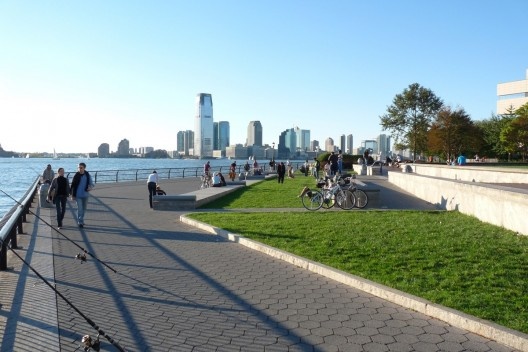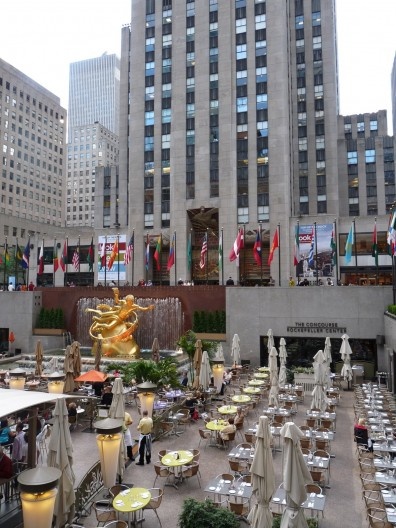
Lower Manhattan e o encontro com as águas do Rio Hudson
Foto Nicolás Sica Palermo
NS: Manhattan ha sido, desde el comienzo del siglo XX, una de las capitales financieras del mundo. Y el hecho de ser una isla ha sido y sigue siendo una condición importante para el crecimiento urbano. La arquitectura de la parte sur de la isla refleja claramente estos dos aspectos. ¿En qué partes del sur de Manhattan cree usted que hay áreas que podrían ser consideradas patrimonio y deberían de ser preservado? ¿Qué áreas (me refiero a ejes de avenidas, calles o barrios) cree usted que son urbanísticamente interesantes?
KF: Yo siempre he dicho que Manhattan es la única ciudad amurallada en los EE.UU., en virtud del agua que la rodea y define por todos los lados. La parte sur de la isla, sin duda, debe ser preservada en la medida en que es lo más europeo. Estoy aludiendo no sólo a la trama laberíntica de calles de la zona de Wall Street, sino también a la atmósfera mercantil del siglo XIX que permea casi todos los edificios, del edificio Woolworth de Cass Gilbert, al edificio de Aduanas y de la Bolsa de Valores. También existe la muy íntima conexión con el agua añadida a la experiencia "máquina del tiempo" del transbordador de Staten Island. Cada vez que estoy allí siento que estoy de vuelta en Liverpool. El World Trade Center de Yamasaki alteró totalmente este tejido y su desaparición violenta lo ha alterado aún más.

Rockefeller Center, 1928-1938 (projeto final), 1938-1940
Foto Nicolás Sica Palermo
NS: ¿Qué oportunidades de expansión aún existen en Manhattan? ¿Deberíamos hablar de reformulación en lugar de expansión? ¿Qué recientes intervenciones parecen pertinentes y podrían ser tomadas como referencias para el futuro de otras partes de la ciudad?
KF: En general Manhattan es una trágica historia del capitalismo tardío en la medida en que desde hace tiempo ha sido un "free-for-all" (competencia o competición sin reglas) para los promotores. Aunque exista la ilustre Comisión Municipal de Planeamiento Urbano, no hay ni una idea coherente de desarrollo de la ciudad sobre la mesa. Es significativo el hecho de que nunca ha habido ahí un arquitecto de la ciudad de Nueva York. De vez en cuando un gran edificio aparece, el Edificio Seagram de Mies, el Guggenheim de Wright y, más recientemente, los de Piano para el New York Times, pero aparte del Rockefeller Center -que sigue siendo un logro milagroso - el siglo XX no aportó nada de importancia urbanística a Manhattan y no hay indicios de que en el siglo XI se hará algo mejor. Es por lo general una mezcla de edificios de arquitectura moderna mediocres unidos por una parrilla ya impuesta. Por supuesto, uno debe reciclar su tejido con calidad siempre que sea posible acompañado del principio de Peter Buchanan "long life-loose fit" (9).
nota
9
"The built environment accounts for about half to two-thirds of our current energy use; this alarming statistic is exacerbated by our present attitudes towards impermanence, commodification, and the rapid amortization of building stock. Buchanan goes on to show that historic buildings arc inherently more adaptable to re-use than modern structures, first because they were built to more generous standards and second because they were constructed of more durable natural material. Moreover, from the point of view of Junction they tended to be 'long life, loose fit' structures; that is to say, they may be much more readily adapted to re-use than more modem, ergonomically optimized building forms.
In relation to the potential for the adaptive re-use of pre-existing structures we should surely restrict our current habit of exploiting ex-agricultural 'greenfield' sites in favor of re-using ex-industrial brownfield sites. Rather than continuing to proliferate urban sprawl, we should either reuse obsolete buildings or demolish them and re-use their sites once they have been cleared. Only provisions of this order will save us from the continual consumption of fertile land and along with this, the ultimate depletion of the planet's non-renewable resources". Frampton, Kenneth. "On the Predicament of Architecture at the Turn of the Century", in: Hunch 6/7: 109 Provisional Attempts to Address Six Simple And Hard Questions. Rotterdam, The Netherlands: The Berlage Institute, episode publishers, and the authors. ISBN 90 805362-6-1, 2003. 516 pp.



